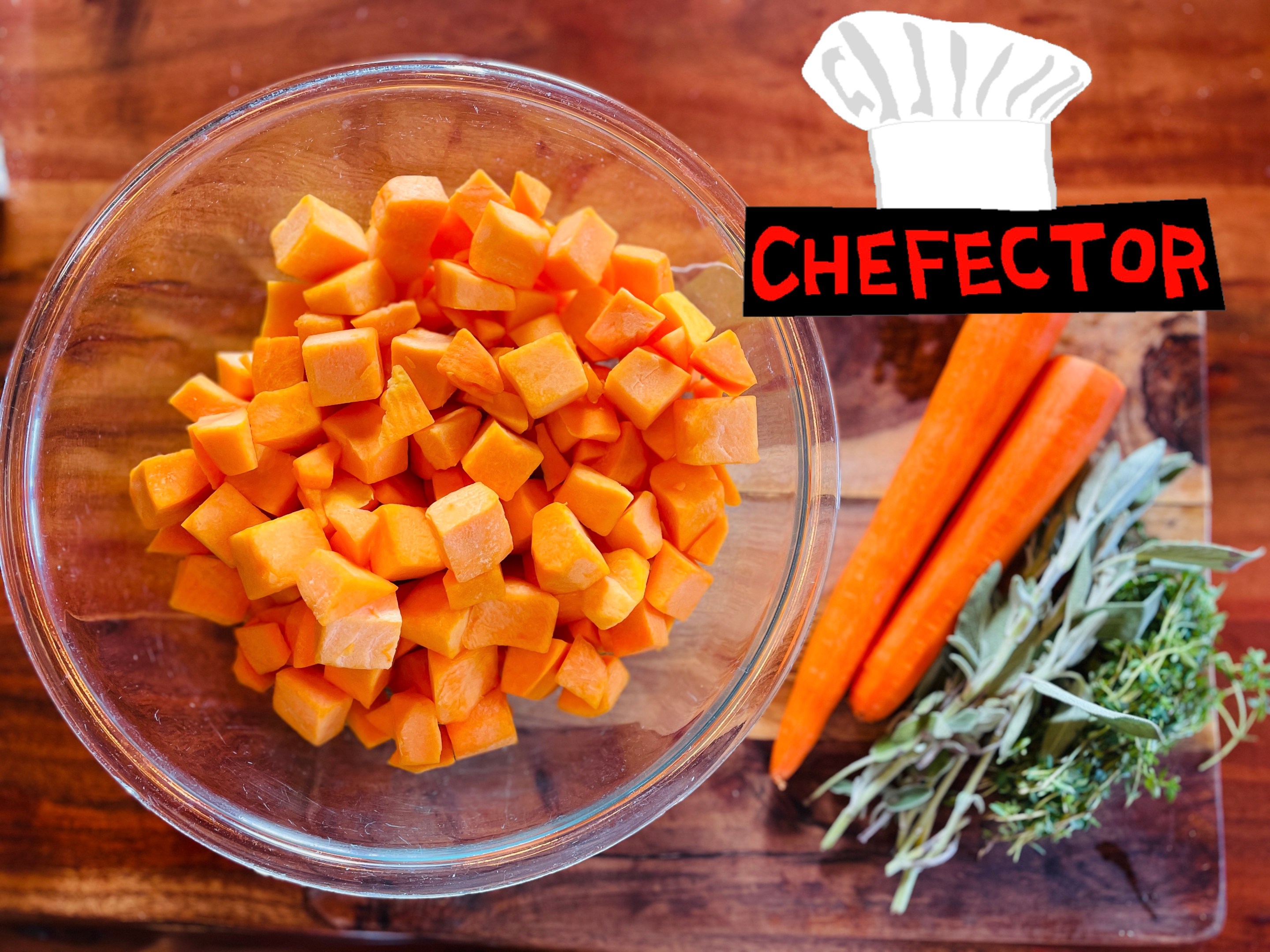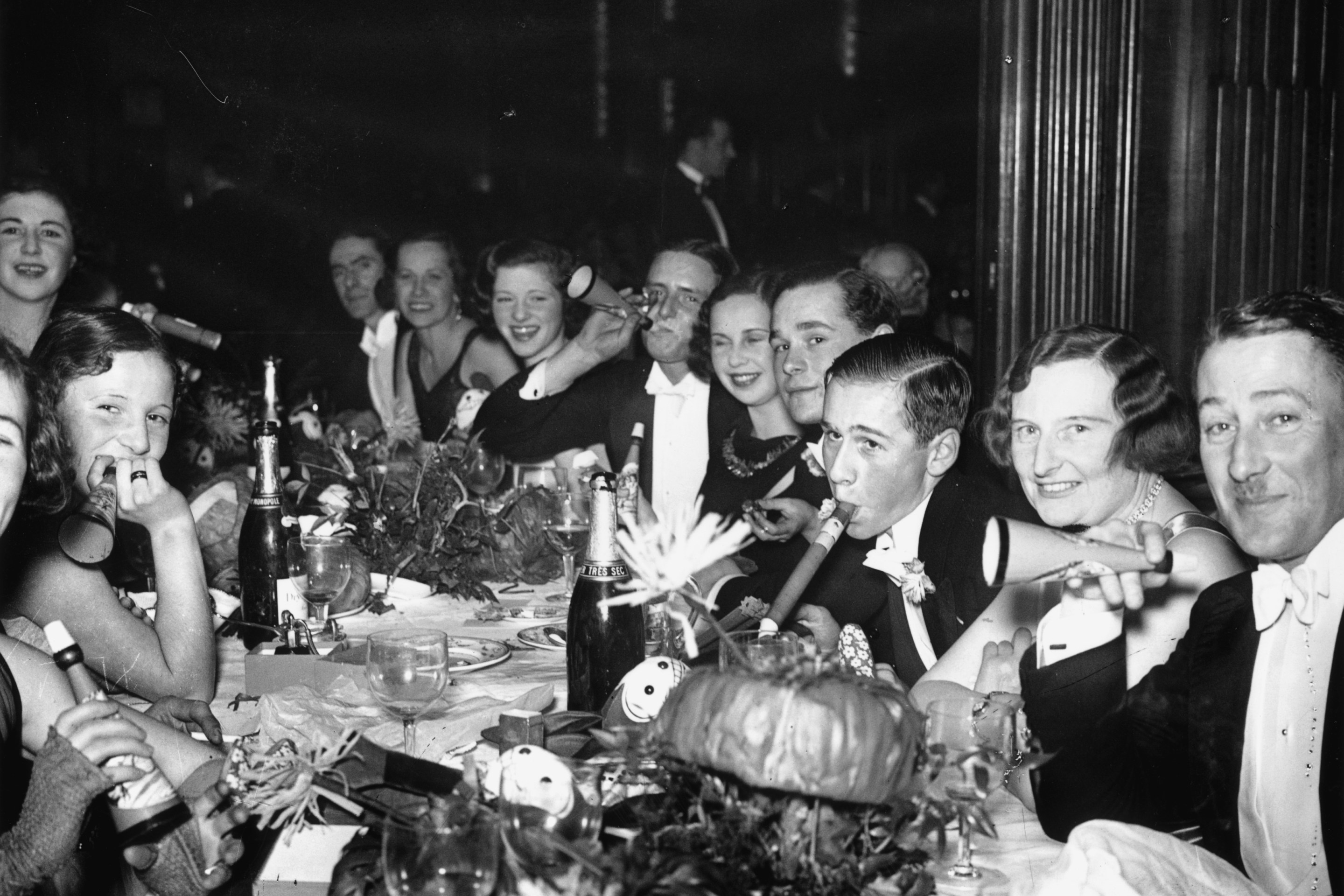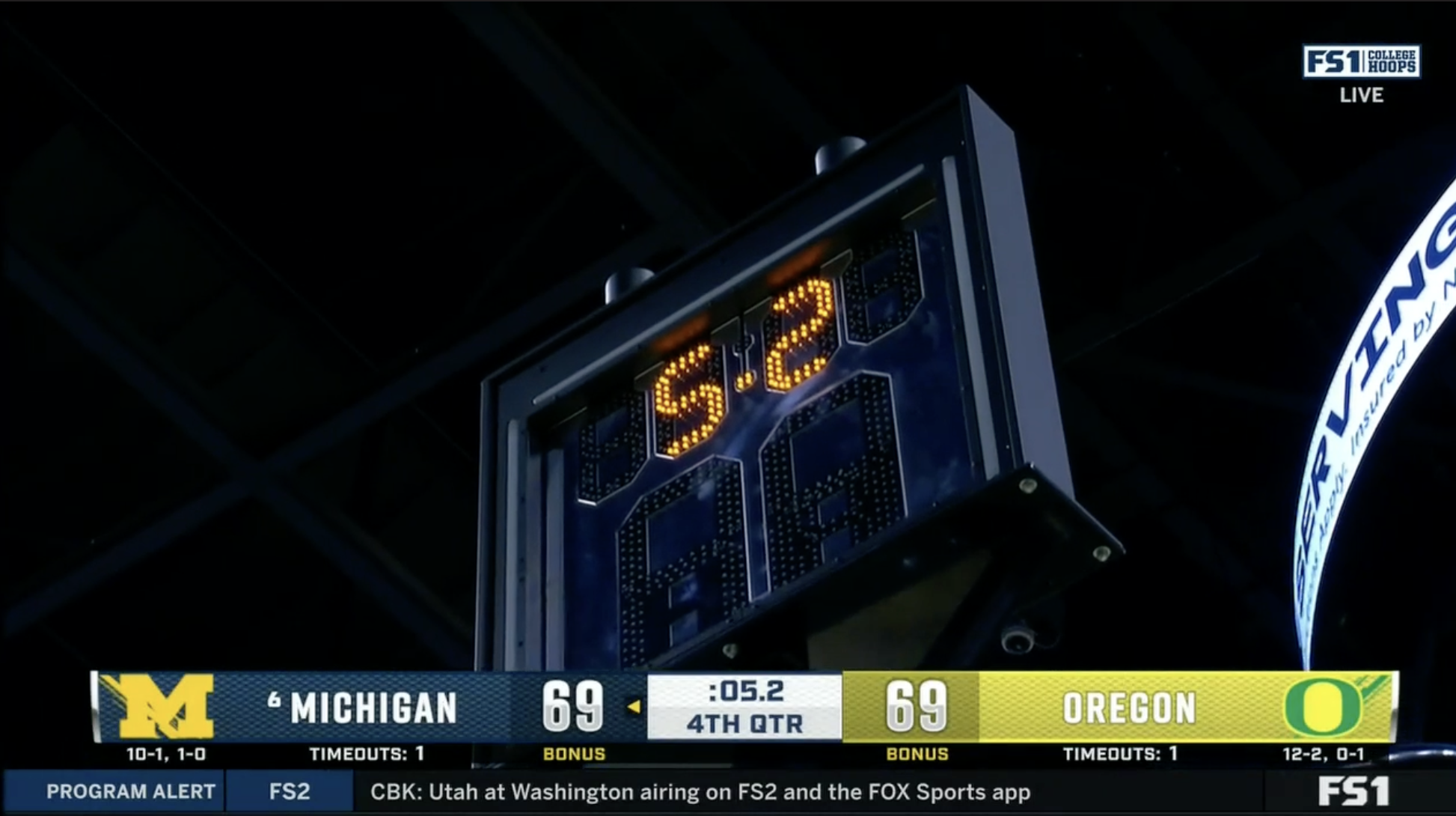Butternut squash soup is not the sort of thing to have Deep Thoughts about. I promise I am not saying that only because it hustles us along through the introductory section of this blog with minimal sweat on my part. Its virtue, apart from just being a nice, tasty thing to eat, is that it is extremely easy—both to cook and to choose to cook—and then tastes and looks a lot fancier than it really is. The thought it results from is just that you want some.
Yes, a handful of easy-to-find ingredients, a handful of easy-to-follow steps, a nice hearty bowl of hot soup perfectly matched to cold weather and early dark. How much more of life could be thus, were it not for the crushing machinations of—no, I'm kidding, none of that. Let's just make some butternut squash soup. It's enough for a thing to be good.
Here are some things that you will need.
I suppose it goes without saying that you will need some butternut squash. Otherwise this would be some pretty fucked-up butternut squash soup! As for how much: The last time I made butternut squash soup, I used a single large butternut squash, which came to just shy of three pounds of, uh, squash... meat (?). Anyway between that and the other ingredients, I wound up with enough reasonably hearty soup to fill ordinary soup-bowl-sized bowls for five people. (It was delicious, thanks.)
You can use this as your starting point. If you have extra people, or want extremely thick and hearty and, uh, squashy butternut squash soup, maybe you go for an extra squash. That is up to you, and none of my damn business. In my experience it is hard and annoying to scale butternut squash soup up or down in increments smaller than "a squash." Like you cannot just go to a bulk tub of Squash Hunks and scoop out a few. It's kind of an all-or-nothing type of deal, is what I am saying.
Nowadays some supermarkets have cubed butternut squash in a nice little shrink-wrapped tub. At my local one, each tub has around one big squash worth of squash in it. I think that's terrific. If you can't get this, then you will have to peel and cube your butternut squash. I covered this a long time ago. For the sake of keeping this blog shorter than the collected works of Charles Dickens, I'll summarize here: Hack half an inch off either end of the squash so it'll stand upright on the counter. Peel the skin off it with a vegetable peeler. Halve it lengthwise. Scoop the seeds and guts out of each half with a spoon, and discard them. Then hack the peeled and de-gutted squash halves into, oh, one-inch cubes. There.
You will also need some other vegetation. One or two big carrots, peeled and cut into hunks; a large yellow onion, diced. This paragraph is short enough that I can also include some herbs in it. Thyme and sage and bay leaf will give your butternut squash a nice autumn/winter vibe. With kitchen twine, tie some sprigs of thyme and sage together with some bay leaves.
You will need stock, probably around, oh, two or three quarts of it. Chicken stock is grand; vegetable stock is also grand, if you prefer a vegetarian/vegan-friendly butternut squash soup. You will need some milk or cream, probably not more than a cup or two of it; skim or one-percent milk will do your soup no good, so treat yourself to some of the fattier stuff. I'm sure it's fine for this to be non-dairy milk. You'll need cooking fat. Some of it will be for sweating onions and some of it will be for tossing the squash hunks before they go in the oven. I recommend butter for the former and some kind of mild oil (light olive oil or grape seed oil or canola or whatever) for the latter. If I am talking to the type of jovial doofus who believes every food preparation must include pork fat in order to maximize its Manliness, well, there's really nothing I can do to stop you from using rendered pancetta or bacon fat for either or both of these purposes, though I don't really recommend it.
Some grated or ground nutmeg would serve your butternut squash soup quite well. While we're discussing small granular things that ought to go into your butternut squash soup, clearly you will need salt.
Then there is the matter of sugar. You know which lecture is coming. You already knew it was coming. Ideally your butternut squash soup will have some nice smooth sweetness to it. This can be because you give the onion and squash and carrot the loving application of cooking time they need in order to develop their own sweetness, or it can be because you scoop some sugar into your pot of butternut squash soup. Which you choose is between you and your own damn self-respect! (Either is fine, really.)
That's really it. There are many other recipes for delicious butternut squash soups out there—curried versions! Less-wintery versions with, like, summer herbs in them! And so forth!—and I heartily recommend that you seek them out and try them once you've got a handle on this very simple and straightforward one. But first, let's actually cook this stuff.
Preheat your oven to 400 degrees, perhaps while you chop all the stuff up in the ingredients section up there. Once you've got it chopped, it's time to prepare the squash and carrots for roasting, and roast them: In a big bowl, toss the squash and carrot hunks with, oh, a glug or two of whichever oil you chose for this purpose, plus a pinch of salt. Spread them out as evenly as you can manage in a single layer across a baking sheet lined with parchment paper, and sock 'em in that hot oven for oh, what the hell, let's say 20 minutes. After those 20 minutes, pull the baking sheet out and use a spatula to flip as many of the hunks as you can tolerate jacking around with before you conclude that this is a stupid waste of time, and then shove 'em back in the oven for another 20 minutes.
Your goal here is squash and carrot hunks that are not just softened by the heat, but also here and there browned on their corners and along their edges. This makes them sweeter and tastier. Do not give into the temptation to try to make this happen faster by roasting them at 450 degrees, or you will end up with blackened veg-wads nearly as bitter as the regret you will feel for not having heeded my warnings.
(If you are cooking for lots of people, and thus using a truly extreme volume of squash, I am sorry to say that you will have to work in batches, here. A double-layer of squash and carrot hunks will steam away to baby food before it will ever brown in there. It's important for the hunks to have at least some small amount of space from each other.)
While the squash is doing its thing in the oven, haul out a nice big heavy pot and cook your onions in whichever fat you chose for this purpose. Sprinkle them with salt and move them around now and then so they cook evenly over, oh, medium heat. Again: Do not rush things. It's fine for your onions to sauté like this for a pretty long time, so long as they're moving around every couple of minutes; it's fine for them to hang out in the bottom of that pot for as long as the squash and carrot are in the oven. If this should lead to them becoming caramelized, great. If not, that is also fine; they will have benefited from their cooking time either way.
Eventually those orange suckers will have come out of the oven. Or, well, they are not going to do that on their own, I suppose. After a while, in accordance with the instructions in this blog, you will remove them from the oven. Dump the squash and carrots into the pot with the onions and toss everything around with your trusted implement.
Why did I not cook the squash and carrots in the pan with the onions, you are now asking, not unreasonably. It is very simple: Unless you are using a pot the size of Wilmington, North Carolina, there will not be enough area in the bottom of it for all these hunks of vegetation to have some space between them; they will be all crammed against and on top of each other, and so instead of browning attractively and becoming nice and sweet within a reasonable timeframe, they will just steam in their own liquids for a very long time. After many hours of cooking, with lots and lots of tossing and turning, eventually they might brown, but in nowhere near the same timeframe as if you cook them in a single layer on a big cookie sheet in the oven. This is the same reason why you can't cook a double-layer of squash and carrot hunks in the oven, as admonished somewhere back there in an earlier portion of this blog. Moving on now!
You're closer than you might guess to being done, at least along a list of steps. You have a big pot with a bunch of squash and carrots and onion cooking in the bottom of it. Pour in your stock until there's as much soup as you want in there. Bring this up to a boil, then lower the heat to a simmer. Oh hey and also, chuck in a modest pinch of that grated or ground nutmeg, and stir. Mmm, smells great. I can smell it from here. Now it's choosin' time.
If you have an immersion or stick blender, at basically any time you can decide you're ready to plunge that sucker down in there and turn this stuff from a pot of hot stock with some cubes of vegetal matter floating in it into a rich, hearty squash soup. In that case, why not go ahead and do it now, and then, once it's all blended, taste it, add however much salt (and sugar, if you went that route!) you think it needs, add your bouquet of herbs, and let it simmer gently, with the occasional stir to keep the solid stuff from settling too long on the bottom of the pot, for, oh, 40 minutes.
If you do not have an immersion or stick blender, you can either:
- Run this stuff through your blender in batches, then return it to the pot, salt (and sugar) it, add your bouquet of herbs, and let it simmer gently, with the occasional stir to keep the solid stuff from settling too long on the bottom of the pot, for, oh, 40 minutes.
- Or, add your bouquet of herbs now, and let the soup simmer gently, with the occasional stir to keep the solid stuff from settling too long on the bottom of the pot, for, oh, 40 minutes—and then remove the bouquet, run this stuff in batches through your blender, then salt (and sugar) it.
- Or, decide that what you want is actually hot broth with big chunks of butternut squash and carrot in it, and skip all the blender steps altogether: Add your seasonings and bouquet of herbs, let it simmer for a while, et voila.
It's up to you, and I don't give a damn!
When you've sorted all that out and taken whichever route you chose, you'll be very nearly done. If you blended your soup and simmered it for the recommended length of time, now you'll finish it. Turn off the heat, and stir in that cup or so of fatty milk product. (If you did not blend your soup, I dunno, somehow it seems weird to me to imagine stirring fatty milk into what's basically just thin broth. But you can suit yourself, here.) Taste again. Does it need salt? Sugar? Make your last adjustments. Ladle it into bowls.
For such simple stuff, this soup covers a lot of bases: It's gently sweet, and nutty, salty enough to keep your palate awake; it's rich and hearty and warming. Over the course of a full bowl it has the heft of a meal. It's even pretty to look at, if you're particularly capable of finding the color orange lovely. A good soup, a fine thing to be.







